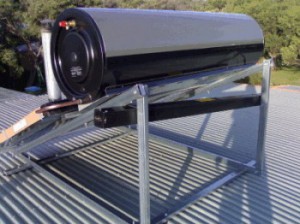Connecting a Wood Stove to a Solar Water Heater
(using a wood stove with a wetback or water jacket, or using the flue)
Solar hot water and wood heaters make the perfect combination. With a correctly sized solar hot water system, the sun will provide at least 70% of a household’s hot water needs. However, in the colder months, solar hot water systems may need boosting, and this is when households with wood heaters can be using them to keep the house warm.
So why not use some of that heat going up the flue to heat the water? It makes good sense to use wood heaters or stoves fitted with water jackets, otherwise known as ‘wet-backs’, to provide hot water boosting.
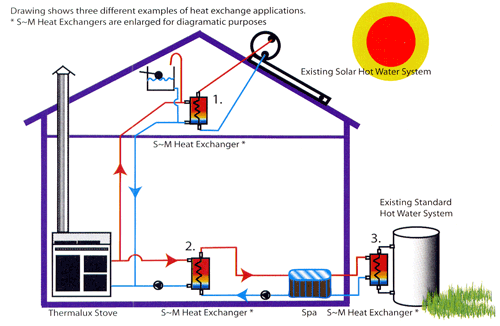
Electric and gas boosters have thermostats to switch them off when the hot water systems storage tank reaches a predetermined temperature, normally 65°C, but wood heaters, on the other hand, are an ‘uncontrolled heat source’. This means that the input of heat from the firebox to the hot water storage tank cannot be easily and quickly switched on or off; wetbacks will just keep on adding heat whilst the fire is going. We recommend that you never cut off the water flow to the wetback, as this can cause a potentially explosive build-up of steam, and running the fire with an empty wetback can cause it to burn out very quickly, reducing its lifespan.
There are two options for dealing with this safely. Both options require the hot water storage tank to be located above the wood heater and sufficiently high so as to ensure the wetback always has water in it. The systems thermosyphon heat transfer must not be impeded by any constrictions. As the water heats up, it is critical that the flow of hot water up to the storage tank and the return of cooler water back down to the wetback is not impeded.
Connecting a stove wet-back to a low-pressure hot water storage tank
Some solar hot water systems have the storage tanks ‘open vented’ so that the main body of stored hot water is not under mains pressure. These systems either rely on gravity feed to supply the hot water to the house or they have their own internal heat exchanger coil inside the tank, with the water inside the heat exchanger supplying the house at mains pressure. Wetbacks can be safely connected directly to the low-pressure open vented part of these tanks, so with these systems, a separate heat exchanger is not required.
Connecting a stove wet-back to a mains pressure hot water storage tank
Using wood fires to boost mains pressure solar hot water systems works best with the traditional roof-mounted ‘close-coupled’ solar tanks because the solar tank is located above the level of fire. Most solar hot water storage tanks are at mains pressure and therefore need to use a heat exchanger, which is normally installed in the roof space, or on the roof, just below the level of the solar hot water storage tank.
In principle, this is a simple device with one pipe inside another, larger pipe. The outside pipe usually has the water from the wetback flowing through it and is ‘open vented’ at low pressure, whilst the inner pipe transfers heat from the outer pipe into the solar storage tank at mains pressure. The outer pipe has an extension rising up to a small open vented make-up or header tank situated just above the centreline of the main storage tank. Any water lost due to the wetback reaching the boiling point is replenished from this header tank. Heat-exchangers and their header tanks are available through Solazone. Many solar roof tanks in Australia’s cooler states have glycol (a frost-resistant heat transfer fluid) going through the solar collector panels and a separate heat exchanger within the solar tank. In these types of systems, it is this fluid, glycol, that the water from the wetback heats in the heat exchanger suspended inside the roof space below the solar unit.
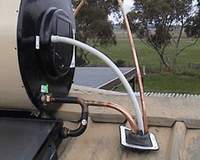
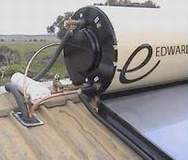
Using a wood fire on a winter’s day to keep warm, while at the same time boosting the solar hot water system, allows households with this set-up to enjoy free hot water all year round. Well-maintained wood fires burn so efficiently that they produce relatively small quantities of greenhouse gases, using the renewable resource of wood. In fact, they emit less than 20% of the greenhouse gases emitted from open fireplaces! Wood is not a fossil fuel and can be harvested from timber planted for wood and firewood.
These pictures show an Edwards LX solar hot water unit connected to a wood-fired stove, using an encased 2-metre heat exchanger. Mains pressure can be maintained for the hot water service, whilst the stove circuit is open vented for safety.
Connecting an LX model Edwards Solar is easy using a heat exchanger. The glycol circuit of the Edwards unit is connected to the heat exchanger, and the stove side of the heat exchanger is maintained at low pressure using the supplied stainless steel top-up tank. The glycol circuit of the Edwards LX must never be connected directly into the woodstove. This would void the warranty and cause a potentially very dangerous situation.
For Roof-mounted tanks, this is how it works
- The heat exchanger is usually installed immediately below the solar hot water tank, either inside or outside of the roof, with a definite slope on it to assist in heat transfer.
- The stove water pipes must be installed with a continuous slope downwards towards the stove, with no flat or up-hill sections to cause heat blocks.
- In general, the slope must at least 1 in 10, and the pipe diameter at least 20 mm.
- The hot pipe should be well-insulated all the way up, as should the entire heat exchanger.
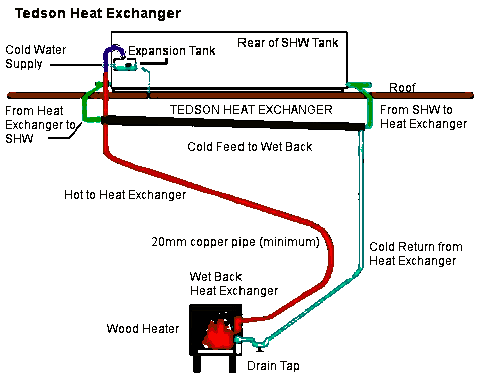
Other types of Heat Exchangers are also available to suit unusual situations. Feel free to ask what would be best suited to your particular application.
Thermosyphon Kit
Designed to connect up your mains pressure solar water heater with its tank located on the roof, to your wood stove located below.
It includes:
-
- Two-metre long Tedson heat exchanger
- 12-litre top-up tank with float valve for the stove circuit
- Splash tray for the top-up tank, if it is to be installed inside the ceiling space.
- Installation instructions and plumbing diagram.
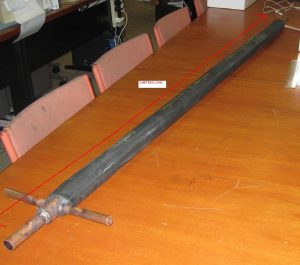
Tedson bare copper heat exchanger (uninsulated)
Connecting a Tedson Heat Exchanger
For Ground-mounted pumped systems, this is how it works
- Usually, the pressure in ground-mounted tanks is higher than you can put through the wetback of the stove, so a heat exchanger is required for the different pressure fluids.
- You will also need an overflow and top-up tank for the stove circuit to allow for the chance of boiling if the heated water is not being used.
- Here is the ground-mounted tank high-pressure installers kit:
- Stove flue heat exchanger (unless wood stove has a wet-back): $795
- Solarmio Compact heat exchanger: $899
- 4 litre Header tank and top-up tank: $295
- Pump and controller: $690
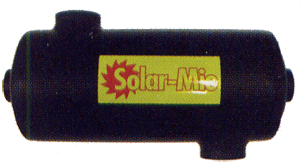 Solarmio compact wood stove heat exchanger |
This heat exchanger is primarily used for pumped systems, connected to ground tanks, or where the height difference is insufficient for thermosyphon to work.
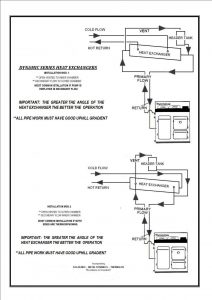
Download Heat Exchanger Plumbing Instructions Diagram here
Overflow, expansion and automatic top-up tanks
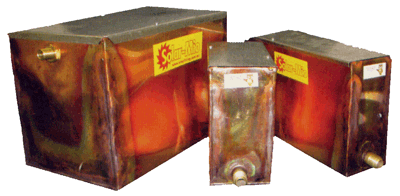 Various sized copper and stainless steel top-up tanks with ball valve |
Various sized copper and stainless steel top-up tanks are available, with ball valve for automatic filling.
For heating from the stove flue (when the stove has no water jacket)
Stainless steel stove flue heat exchanger fits to the base of any standard 6 inch stove flue base, to capture waste heat going up the flue, and use it to heat water.

Australian-made top-quality stove-flue heat exchangers.
Heat -Exchangers & top-up tank Prices – March 2022
| Tedson 2-metre bare copper heat exchanger (uninsulated, use for in-roof connections only) | $875 |
| 10 Flat plate heat exchanger | $970 |
| 20 Flat plate heat exchanger | $1390 |
| Solar Mio 830mm compact high performance heat exchanger (only for pumped systems) | $899 |
| Header Tank 4-litre copper expansion tank & ball valve | $295 |
| Header Tank 12-litre copper expansion tank with ball valve, check valve & tray | $450 |
| Header Tank 22-litre copper expansion tank with ball valve, check valve & tray | $495 |
| 3-litre Insol Stainless steel top up tank & ball valve | $475 |
| Solar North stove flue hot water heat exchanger | $795 |
| Aust-made stainless steel Standard stove-flue heat exchanger – 150 diam x 620mm |
$860 |
| Aust-made stainless steel Maxi stove-flue heat exchanger – 150 diam x 780mm | $1130 |
| Aust-made stainless steel Super stove-flue heat exchanger – 150 diam x 1030mm | $1380 |
Prices do not include delivery from the factory.

